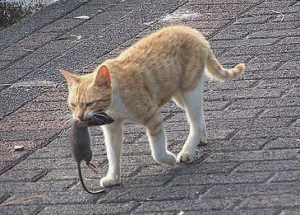
During my tenure as executive director of Maricopa County’s Animal Care & Control (1998/2003), I prevailed upon the County Board of Supervisors, with the support of Public Health Director, Dr. Jonathan Weisbuch, to proclaim Trap/Neuter/Return (TNR) the County’s official methodology for humanely reducing feral cat populations.
In addition to reducing the killing in local animal shelters, another benefit to implementing TNR in our cities is that managed feral cat colonies serve as a toxin free rodent abatement program. TNR ends the need for poison to control rodent populations and I think we can all agree that this better for our environment, our wildlife and our pets.
Maricopa County ahead of its time

I’m not sure if Maricopa County’s support for TNR is as robust as it once was but the fact remains, their TNR policy was a decade ahead of the times.
Recently, support for a TNR Public Health policy in all US cities was bolstered by the results of a study of New York City’s residential mouse population. The study found city rodents carry viruses and bacteria capable of causing life-threatening human illness –- and some of the bacteria were found to be antibiotic-resistant.
The study, conducted by Dr. W. Ian Lipkin, a professor of epidemiology at Columbia University’s Mailman of Public Health, was recently published in mBio, the journal of the American Society for Microbiology.
Lipkin’s team collected 416 mice from residential buildings, garbage disposal areas, commercial food preparation/storage areas, and a private apartment.
Summing up his findings, Lipkin said, “Mouse droppings may contain harmful bacteria that are difficult to treat with common antibiotics. Contaminated areas should be thoroughly cleaned, and contaminated food should be discarded.”
Results of the study were released in two papers.
In the first paper, Lipkin’s team reported 235 separate genera and 149 distinct species of bacteria, including the most common causes of gastrointestinal upset: C. difficile, E. coli, Shigella and Salmonella.

Salmonella is a leading cause of bacterial food poisoning in the US, causing 1.2 million reported cases, including 450 deaths every year. Analysis of the bacteria found evidence of antimicrobial resistance to several common antibiotics.
A second paper focused on the viral load of the mouse droppings.
Researchers discovered 36 separate viruses, including six new ones. None of the viruses identified by the researchers is known to infect humans, however, the genetic sequences matched those known to infect dogs, chickens and pigs – suggesting some of the viruses crossed over from other species.
“Mice are more worrisome [than rats] because they live indoors and are more likely to contaminate our environment,” said Lipkin.
What this means for your city
Professor Mark Viney, a biologist at the University of Bristol, said the findings “would probably be pretty similar across any city in the world, because what you’ve got in cities is lots of people and rats and mice living closely together.”
Viney conducts related studies on the immune responses of wild mice but was not involved in this study.
According to Viney, wild mice have elevated immune responses because they are exposed to infections, bacteria, viruses, worms, fleas and ticks.
Now that we know city mice carry infectious disease, the big question is: Where do these bugs come from originally, and what are the consequences?
“We have no idea,” Viney said “more study is needed”.
Lipkin agreed, stating, “The next step is to determine whether [human] outbreaks of infection with bacteria can be traced back to exposure to mice.”
OR we could introduce an ounce of prevention by implementing managed TNR programs in our cities and end the threat of rampant disease before it occurs.
For more information on how to implement a formal TNR program in your community contact Ed Boks here.
